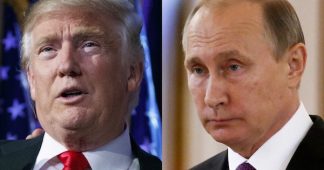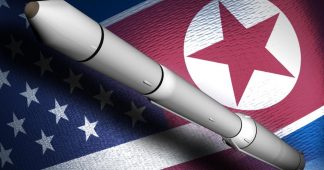To say the truth we don’t understand much of what is going on with North Korea and, in particular, the huge concessions just announced from its regime.
If we don’t understand, that probably means there is a lot of things going on we ignore.
The only thing we believe is clearly impossible is for people like Trump, Pompeo or Bolton to do anything promoting peace and stability anywhere in the world.
It is also clear that the present Imperial leadership wants very much to use the threat of the nuclear war to provoke divisions among its immediate nations-targets (Syria,Lebanon, Iran, North Korea, Russia, China). It would also like to provide with arguments any open or hidden potential oppositions inside those nations.
We reproduce the following article published by WSWS.org, not because we share necessarily its analysis, but because we consider useful to bring it to the attention of our readers.
D.K.
Trump’s secret diplomacy with North Korea
19 April 2018
Just months after threatening North Korea with nuclear annihilation, US President Donald Trump confirmed that CIA Director Mike Pompeo had visited Pyongyang over Easter and met with North Korean leader Kim Jong-un in preparation for a projected Trump-Kim summit. Having derided former Secretary of State Rex Tillerson for “wasting his time” in trying to negotiate with North Korea, Trump is now preparing to meet face-to-face with the leader he ridiculed as “Little Rocket Man.”
The abrupt about-face does not express any fundamental change of heart on the part of Trump, who has just unleashed illegal missile strikes on Syria. Rather the Trump administration senses the possibility of advancing US imperialism’s interests and strengthening its position in North East Asia against its chief rivals, Russia and China, and potential competitors such as Japan.
Trump’s overtures to the Pyongyang regime parallel the sudden turn by the right-wing US President Richard Nixon toward China. Nixon’s national security adviser Henry Kissinger conducted a series of secret trips to Beijing in 1971 to establish the basis for Nixon to meet with Chinese Communist Party Chairman Mao Zedong in February 1972. Nixon’s rapprochement with China, which was aimed against the Soviet Union, laid the basis for capitalist restoration in China and its transformation into the world’s premier cheap labour platform.
It is by no means certain that a Trump-Kim summit will produce a deal between the two countries. While meeting with Japanese Prime Minister Shinzo Abe on Tuesday, Trump told the media that the summit would be a “great chance to solve a world problem,” adding: “We’ll either have a very good meeting or we won’t have a good meeting. And maybe we won’t even have a meeting at all, depending on what’s going on.”
Nearly 50 years after the Nixon-Mao meeting, the US regards China as the chief obstacle to global hegemony. Under President Barack Obama and now Trump, the US has mounted a comprehensive diplomatic and economic offensive against China across the Indo-Pacific, calculated to undermine Chinese influence and prepare for war. In the past several months, there has been a rapid deterioration in relations with Beijing, featuring threats of trade war, and also with Russia over Syria, where the US is seeking to oust Moscow’s ally, Syrian President Bashir al-Assad.
Since the dissolution of the Soviet Union in 1991, the US has systematically isolated North Korea diplomatically and imposed crippling sanctions on its economy. The overriding aim of this strategy was not to end the supposed threat posed by the country’s tiny nuclear arsenal, but rather, by one means or another, to bring it into the US sphere of influence. Moreover, the US is certainly not preoccupied with the human rights abuses of the oppressive military/police-state regime in Pyongyang.
Having strong-armed China into dramatically tightening the economic noose around its ally, Trump may well be calculating that he might be able to “flip” North Korea, transforming it from a US foe to an ally in Washington’s confrontation with China and Russia. In the rivalry for imperialist dominance in North East Asia, the Korean Peninsula, which borders both Russia and China, has always been critical strategically. The US-led Korean War of 1950–53, which cost millions of lives, was fought for domination of Korea. It was regarded in Washington as the precursor to a wider war against China, whose entry into the conflict dashed US hopes.
Since Kim Jong-un came to power in 2012, North Korea’s relations with China have worsened markedly. Kim’s visit to Beijing last month to meet with Chinese President Xi Jinping was his first, and was no doubt aimed at shoring up his options ahead of the summit with Trump. The paramount aim of the North Korean regime in two decades of failed negotiations and deals has been self-preservation—a peace treaty to formally end the Korean War and security guarantees from Washington. In comments on Tuesday, Trump declared that he had given his “blessing” to South Korea to discuss a peace treaty in talks between Kim and South Korean President Moon Jae-in later this month.
Significantly, Trump chose to reveal Pompeo’s trip to Pyongyang in the middle of his meetings with Japanese Prime Minister Abe. Just as Nixon blindsided Japan in announcing his trip to Beijing in 1972, Trump kept Abe in the dark—firstly over his announcement of a summit with Kim and now with his “extremely high level” secret diplomacy. Abe who has been just as bellicose toward North Korea as Trump, using its missile-testing as a pretext for remilitarisation, confronts the possibility of a Pyongyang-Washington deal that cuts across Japanese strategic interests.
Trump’s shift on North Korea is bound up with his acute political crisis at home as well as external geo-political considerations. Facing multiple scandals and ongoing attacks over his failure to take a tougher stance against Russia, Trump might see the opportunity to answer his critics by orchestrating a diplomatic coup to solve “a world problem”—to Washington’s advantage. His move is certain to provoke determined resistance from Trump’s factional opponents in ruling circles, as already indicated by the initial hostile reaction of the New York Times to Pompeo’s secret trip.
It is too early to say what will emerge from a Trump-Kim summit, or even if it will go ahead. Amid the 1930s Great Depression and mounting dangers of war, international diplomacy was full of surprising twists and turns. Nazi leader Adolf Hitler signed a non-aggression pact with Poland in 1934 and another with the Soviet Union in 1939, only to break them both.
If Trump is unable to cut a deal with the North Korean leader, the summit could rapidly become the setting for a US diplomatic provocation that triggers a devastating conflict on the Korean Peninsula, with incalculable wider consequences. The very fact that Trump has chosen Pompeo, who only last year hinted that the CIA had plans to “separate” Kim from his nuclear arsenal via assassination, is a warning that the pendulum could rapidly shift toward war.
Even if Trump pulls off a diplomatic coup and reaches an agreement with Pyongyang, the least likely variant is that it will lead to a flowering of peace. Far more probable is that it will set the stage for a rapid intensification of the confrontation with US imperialism’s chief targets—China and Russia.
Peter Symonds
Published at https://www.wsws.org/en/articles/2018/04/19/pers-a19.html










